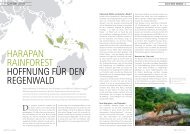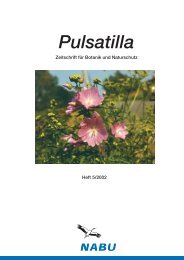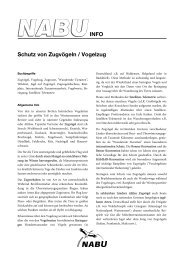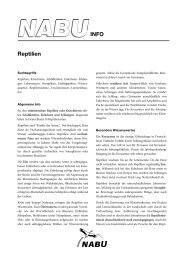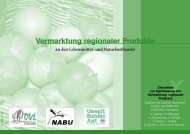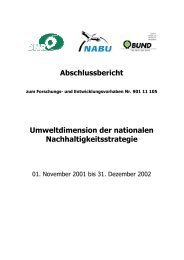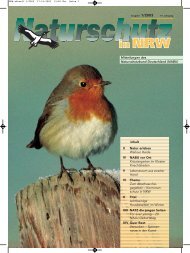Studie "The GMO-emperor has no clothes" (engl.) - Nabu
Studie "The GMO-emperor has no clothes" (engl.) - Nabu
Studie "The GMO-emperor has no clothes" (engl.) - Nabu
You also want an ePaper? Increase the reach of your titles
YUMPU automatically turns print PDFs into web optimized ePapers that Google loves.
utterfly. Navdanya’s studies have shown that<br />
soil micro-organisms are negatively affected.<br />
<strong>The</strong> primary justification for the genetic<br />
engineering of Bt into crops is that this will<br />
reduce the use of insecticides. Bt cotton is among<br />
the ‘miracles’ being pushed by corporations like<br />
Monsanto as a solution to the pesticide crisis. One<br />
of the Monsanto brochures had a picture of a few<br />
worms and stated, “You will see these in your<br />
cotton and that’s O.K. Don’t spray.” However, in<br />
Texas, Monsanto faced a lawsuit filed by 25 farmers<br />
over Bt cotton planted on 18,000 acres which<br />
suffered cotton bollworm damage and on which<br />
farmers had to use pesticides in spite of corporate<br />
propaganda that genetic engineering meant an end<br />
to the pesticide era. In 1996, two million acres in<br />
the US were planted with Monsanto’s transgenic<br />
Bollgard cotton.<br />
However, cotton bollworms were found to<br />
have infested thousands of acres planted with<br />
the new breed of cotton in Texas. Not only did<br />
the genetically engineered cotton <strong>no</strong>t survive<br />
cotton bollworm attack, there are also fears that<br />
the strategy will create super bugs by inducing<br />
Bt – resistance in pests. <strong>The</strong> question is <strong>no</strong>t<br />
whether super-pests will be created, but when<br />
they will become dominant. <strong>The</strong> fact that the<br />
Environmental Protection Agency (EPA) of the<br />
US requires refugia of <strong>no</strong>n-engineered crops to<br />
be planted near the engineered crops reflects the<br />
reality of the creation of resistant strains of insects.<br />
<strong>The</strong> widespread use of Bt containing crops<br />
could accelerate the development of insect pest<br />
resistance to Bt which is used for organic pest<br />
control. Already eight species of insects have<br />
developed resistance to Bt toxins, either in the field<br />
or laboratory, including the diamond back moth,<br />
Indian meal moth, tobacco budworm, Colorado<br />
potato beetle, and two species of mosquitoes.<br />
A new Super Pest which <strong>has</strong> become Resistant to GM Corn<br />
<strong>The</strong> genetically engineered Bt crops continuously<br />
express the Bt toxin throughout its growing<br />
season. Long term exposure to Bt toxins promotes<br />
development of resistance in insect populations,<br />
this kind of exposure could lead to selection for<br />
resistance in all stages of the insect pest on all parts<br />
of the plant for the entire season.<br />
Due to this risk of pest resistance, the EPA offers<br />
only conditional and temporary registration of<br />
varieties producing Bt. <strong>The</strong> EPA requires four<br />
percent ‘refugia’ with Bt cotton, meaning four<br />
percent of planted cotton is conventional and<br />
does <strong>no</strong>t express the Bt toxin. It therefore acts<br />
as a refuge for insects to survive and breed, and<br />
hence keeps the overall level of resistance in the<br />
population low. Even at a 4 percent refugia level,<br />
insect resistance will evolve in as little as three to<br />
four years.<br />
Herbicide Resistant Crops: A Recipe for<br />
Superweeds<br />
Herbicide resistant crops such as Roundup Ready<br />
cotton can create the risk of herbicide resistant<br />
“superweeds” by transferring the herbicide<br />
resistance to weeds. Monsanto <strong>has</strong> confirmed<br />
that a <strong>no</strong>torious Australian weed, rye grass, <strong>has</strong><br />
developed tolerance to its herbicide Roundup,<br />
thus rendering genetic engineering of herbicide<br />
resistant crops a useless strategy.<br />
In 1994, research scientists in Denmark reported<br />
strong evidence that an oilseed rape plant<br />
genetically engineered to be herbicide tolerant<br />
transmitted its transgene to a weedy natural<br />
relative, Brassica campestris ssp. Campestris. This<br />
transfer can become established in the plant in just<br />
two generations.<br />
In Denmark, B. campestris is a common weed<br />
in cultivated oilseed rape fields, where selective<br />
elimination by herbicides is <strong>no</strong>w impossible. <strong>The</strong><br />
wild relative of this weed is spread over large<br />
parts of the world. One way to assess the risk of<br />
releasing transgenic oilseed rape is to measure the<br />
rate of natural hybridization with B. campestris,<br />
because certain transgenes could make its wild<br />
relative a more aggressive weed, and even harder to<br />
control.<br />
Although crosses with B. campestris have been<br />
used in the breeding of oilseed rape, natural<br />
interspecific crosses with oilseed rape was<br />
generally thought to be rare. Artificial crosses by<br />
hand pollination carried out in a risk assessment<br />
project in the U.K were reported unsuccessful.<br />
However, a few studies have reported spontaneous<br />
hybridization between oilseed rape and the<br />
parental species B. campestris in field experiments.<br />
As early as 1962, hybridization rates of zero percent<br />
to 88 percent were measured for oilseed rape and<br />
13



